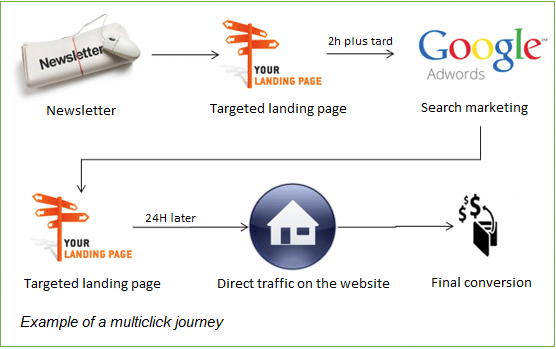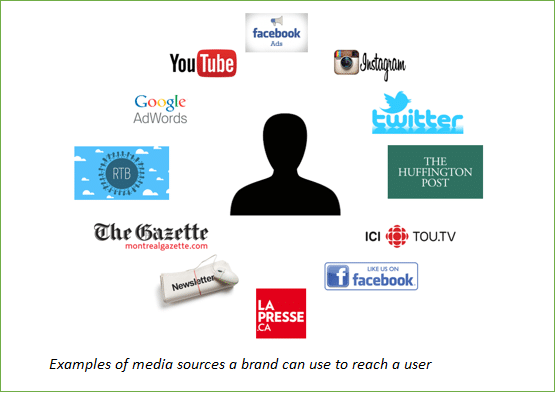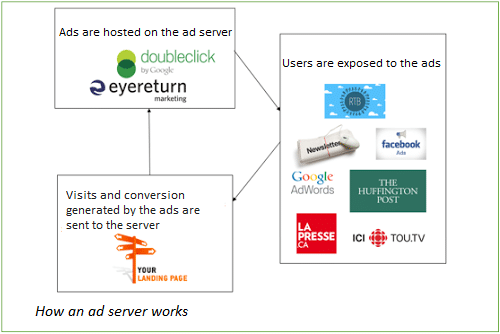Digital Media Practice Lead
Putting an end to post-click attribution
Digital Media Practice Lead
In today’s web marketing world, there are tools to allow you to track just about every action taken on a site. These actions can be measured in several different ways, which means we also have to look at the elements that might be impacting each action. Online, a single advertiser might reach a user through a dozen different sources. Post-click attribution only looks at the last interaction the user had with an ad before completing the desired action. That means we aren’t looking at the bigger picture, which is usually much more complex. In this article, we will explore the attribution methods that will allow you to link the conversions you’re measuring to your business goals.
Soft conversion vs. hard conversion
We can identify different types of conversions on a website. To keep things simple, we’ll divide them into two categories: soft conversions and hard conversions. A hard conversion is a conversion that’s directly related to a business goal (like a purchase).
A soft conversion consists of an action that brings the user closer to a hard conversion. For an ecommerce site, that could mean adding an item to the shopping cart. Here are three smart ways to use them:
- To optimize ad placements. Some algorithms require a certain volume of conversions to be meaningful. In some cases, it’s therefore preferable to optimize for soft conversions to get more data and better performance.
- When hard conversions can’t be measured in real time. For example, a user who downloads an insurance form or credit card application might be refused after their file is assessed. In that case, there would be no direct return for the company because the user would not become a client.
- To identify bottlenecks in the conversion funnel. By tracking all the steps in the payment process, we can identify the problem areas. For example, a process that requires users to register before making a purchase might be a deterrent for some people. In that case, you might collect data that shows the importance of creating a purchase process that doesn’t require registration.
Search marketing conversions
In the early 2000’s, web marketing consisted mainly of search engine marketing. In the beginning, we looked at conversion in a simplistic way: users clicked on an ad, then a certain number of them went on to complete the desired action on the destination site: a hard or soft conversion. In search marketing, because the user has expressed their intention through their choice of keywords, we can expect that they will arrive at the landing page prepared to complete one or more actions.
Take the example of a person who’s searching for “discount jeans.” It’s pretty likely he would click on an ad promoting discount jeans! Once he got to the site, he would want to find the jeans that are on sale, and add them to his shopping cart. Once he did, we could count this as a soft conversion. If the user continued with the purchase process and bought the jeans, we would count it as a hard conversion.
Attribution: Who gets the credit?
Where should we assign the attribution in the case where a user visits a site multiple times? Early models attributed the conversion to the last source leading to the conversion (last click). This type of model is logical when the goal of the campaign is to get a direct response from the user, like entering a simple contest.

We can now admit that this model isn’t appropriate for more complex conversions. For example, in the morning, a user receives a newsletter from a clothing site advertising a promotion. Because they’re in a hurry, the user visits the site for just a few seconds before rushing off to work. At lunch, they go back to the site to shop but this time they get there through search. Then finally, the next day, they go back to the site by navigating directly to it, and complete their purchase. It’s clear to see that here, the last click didn’t generate the purchase!

Here we’re talking about post-click conversions or conversions that come after a website visit. To determine if a post-click conversion should be attributed to multiple sources, we first need to decide on an attribution window. For an item like jeans, we might consider a period of 48 hours between the first visit and the conversion. For a trip reservation or a big-ticket item like a computer, we might use a bigger window (envisioning a longer purchase window). Post-click conversions can be divided into three types:
- Last click: The source responsible for the last visit to the site before the conversion. In this category, we often find direct visits, as well as visits generated by branded queries.
- First click: The source responsible for the first visit to the site during the attribution period preceding the conversion. Here we find visits from social media, as well as visits from display ads, or more generic search queries.
- Assisted click: These are all the visits between the first visit and the final conversion. In the example given above, we would say that the newsletter generated a first click conversion, search marketing generated an assisted conversion, and the last click conversion would be attributed to direct traffic to the site. To calculate ROI by source, we would then need to attribute part of the value of the transaction to each of our traffic sources. In some cases, we would attribute greater value to the first or last click. Other advertisers might decide to attribute equal value to each source. It’s up to the advertiser to build a model that’s consistent with their business goals (and we can definitely help handle this task ).
Display conversions
Google introduced the Google Display Network to its AdWords platform as a way to allow advertisers to buy banners on the Display Network similar to the way they were buying search ads. Conversions were counted only after a user clicked on an ad then completed the desired action. Even today, the default setting in AdWords still measures post-click conversions using a last click model.
In 2016, the reality for display advertising has completely changed. Users are clicking banners less and less. What’s important is exposing users to the brand. And we can’t forget that paid advertising is not solely responsible for generating conversions. The impact of social media or an event sponsorship can also enhance the effectiveness of a campaign.

Brands have the power to reach users through any number of digital channels and mechanisms. A digital media plan might include things like a programmatic buy through Google AdWords, an RTB platform or Facebook Ads, a premium buy on LaPresse.ca, the Huffington Post, MontrealGazette.com or Tou.tv, email marketing, and publishing to social media sites like Facebook, Twitter, Instagram or YouTube. Some media buys aim to spread awareness about a promotion, while others are focused on conversion. The problem lies in figuring out how to attribute conversions to the right source.
If premium placements influence the search volume for your brand, then you see a sudden jump in post-click conversions from Google search, who gets the credit? It’s a puzzle!
Possible solutions from ad servers
When all ads are served by a single server, that server is in a position to connect ads seen and clicked to conversions. So, when a user is exposed to multiple ads before converting, we are able to know all the sources that targeted that user, and share the credit for that conversion. Different types of media buys can have different goals, but the ad server allows us to measure our performance on the same basis, regardless of platform. For example, premium buys might be chosen for their lower cost per visit to your website, or lower cost per soft conversion, two indicators of interest. Programmatic buys, specifically search and remarketing, would usually be optimized to maximize hard conversions.

In this context, we have to be aware of the limits of our tracking abilities. The rise in popularity of ad blockers (that prevent ads from being deployed) and the use of multiple devices by a single user (desktop, laptop, tablet, smartphone) make it difficult to analyze ad server data. In spite of this though, we have to count on the fact that online, we work more with relative measurements than exact data. If the ad server indicates that I get twice the conversions from contextual targeting in AdWords than from contextual targeting on an RTB network, I can deduce that my budget would be more effectively spent on AdWords.
Liked this article? Keep on reading about this topic in this part II.

-1.png)
-1.png)






